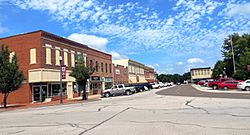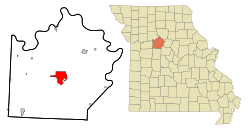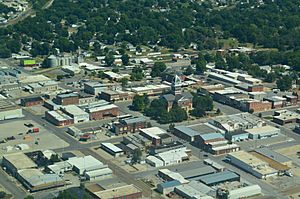Marshall, Missouri facts for kids
Quick facts for kids
Marshall, Missouri
|
|
|---|---|
| City of Marshall | |

North Street in Marshall
|
|

Location of Marshall, Missouri
|
|
| Country | United States |
| State | Missouri |
| County | Saline |
| Area | |
| • Total | 10.20 sq mi (26.41 km2) |
| • Land | 10.12 sq mi (26.22 km2) |
| • Water | 0.07 sq mi (0.19 km2) |
| Elevation | 774 ft (236 m) |
| Population
(2020)
|
|
| • Total | 13,806 |
| • Density | 1,363.96/sq mi (526.63/km2) |
| Time zone | UTC-6 (Central (CST)) |
| • Summer (DST) | UTC-5 (CDT) |
| ZIP code |
65340
|
| Area code(s) | 660 |
| FIPS code | 29-46316 |
| GNIS feature ID | 2395023 |
Marshall is a city in Saline County, Missouri, United States. It is the main city of Saline County. In 2020, about 13,806 people lived there. Marshall is also home to Missouri Valley College.
Contents
History of Marshall, Missouri
Marshall was founded on April 13, 1839. Jeremiah O’Dell donated the land for the city. It was named after John Marshall, a very important judge in the United States. Marshall became the county seat, which means it's where the main government offices for Saline County are.
Early Buildings and Landmarks
The first two courthouses in Marshall burned down. So, the Saline County Courthouse was built in January 1882. This beautiful building is still a landmark in the center of Marshall Square. It was added to the National Register of Historic Places in 1977. This list recognizes important historical places.
Aviation History in Marshall
The Nicholas-Beazley Airplane Company was an American airplane maker. It was based in Marshall, Missouri, in the 1920s and 1930s. At its busiest, the company made about one airplane every day! Airplane production stopped in 1937 because of the Great Depression. Today, you can visit the Nicholas Beazley Aviation Museum at the Marshall Airport. It is full of aviation history.
Music and Culture in Marshall
Marshall has a rich music history. It is the hometown of Bob James, a famous jazz musician. The city also hosts the Foothills Fest Music Festival. The Marshall Municipal Band and the Marshall Philharmonic Orchestra are also from here. The Philharmonic Orchestra has been performing for over 50 years. They often play on the Courthouse lawn during summer.
Jim the Wonder Dog
Marshall is famous for Jim the Wonder Dog. Jim was a special dog in the 1930s. He amazed scientists from different universities. They said he had a unique power. Jim seemed to know the sex of unborn babies. He could also follow commands in many languages. His owner, Sam Van Arsdale, only spoke English. Jim even picked the winner of the Kentucky Derby horse race seven years in a row! He also predicted the New York Yankees would win the 1936 World Series. Jim died on March 18, 1937. There is a park in town named after him.
Marshall During the Civil War
During the American Civil War, Union soldiers were stationed in Marshall. Even though Marshall was not a major military target, it was attacked twice by Confederate soldiers. It was also the site of a battle.
Missouri Valley College in Marshall
Missouri Valley College was founded in Marshall in 1889. It is a private, four-year college. It is connected with the Presbyterian Church (USA). The college campus is about 150 acres. It offers 27 different study programs. About 1,800 students attend the college.
The college's first building, Baity Hall, was built in 1889. It is also on the National Register of Historic Places. It is known for its beautiful wooden staircase and stained glass windows.
Historic Places in Marshall
Besides Baity Hall and the Saline County Courthouse, many other places in Marshall are on the National Register of Historic Places. These include:
- Chicago and Alton Depot
- First Presbyterian Church
- Fitzgibbon Hospital
- Free Will Baptist Church of Pennytown
- Mt. Carmel Historic District
- Utz Site
- Van Meter State Park Combination Building
- Van Meter State Park Shelter Building
Geography of Marshall
Marshall covers an area of about 10.28 square miles (26.62 square kilometers). Most of this area is land. Only a small part is water.
Population and People in Marshall
| Historical population | |||
|---|---|---|---|
| Census | Pop. | %± | |
| 1880 | 2,701 | — | |
| 1890 | 4,297 | 59.1% | |
| 1900 | 5,086 | 18.4% | |
| 1910 | 4,869 | −4.3% | |
| 1920 | 5,200 | 6.8% | |
| 1930 | 8,103 | 55.8% | |
| 1940 | 8,533 | 5.3% | |
| 1950 | 8,850 | 3.7% | |
| 1960 | 9,572 | 8.2% | |
| 1970 | 12,051 | 25.9% | |
| 1980 | 12,781 | 6.1% | |
| 1990 | 12,711 | −0.5% | |
| 2000 | 12,433 | −2.2% | |
| 2010 | 13,065 | 5.1% | |
| 2020 | 13,806 | 5.7% | |
| U.S. Decennial Census | |||
Marshall's Population in 2020
In 2020, Marshall had 13,806 people. There were 4,373 households. About 21% of the people were under 18 years old. The average age in Marshall was 32.3 years.
Marshall's Population in 2010
In 2010, Marshall had 13,065 people. The city had 4,741 households. About 23.8% of the people were under 18 years old. The average age was 32.9 years.
Education in Marshall
The Marshall Public School District provides education for students from kindergarten through 12th grade. As mentioned, Missouri Valley College is also located in Marshall.
Marshall also has a public library. It is called the Marshall Public Library.
Notable People from Marshall
Many interesting people have come from Marshall, Missouri:
- Walt Housman – An American football player.
- Bob James – A famous jazz musician.
- Noble Johnson – An actor.
- Chelsea Liu – A figure skater.
- Robert Pearson McChesney – An artist.
- Doc Quigg – A journalist.
- Twila Tanner – A contestant on the TV show Survivor: Vanuatu.
Notable Animal from Marshall
- Jim the Wonder Dog – A famous hunting dog with a park named after him in town.
See also
 In Spanish: Marshall (Misuri) para niños
In Spanish: Marshall (Misuri) para niños


